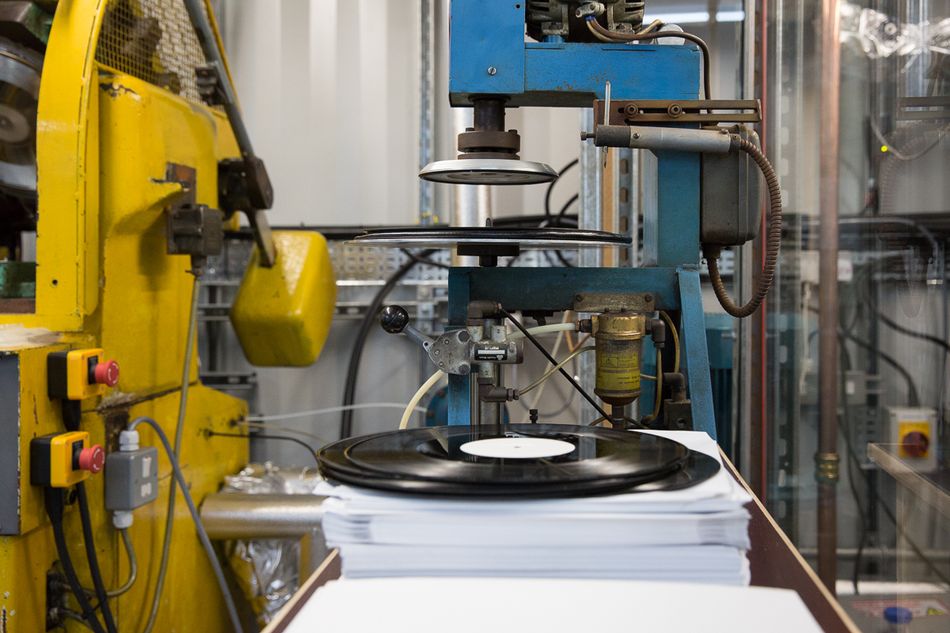Bob Bailey is an engineer who worked in EMI’s record pressing plant for more than 30 years. Since 2001, he has worked at the Vinyl Factory, an organisation that runs a record label, pressing plant, record shop and magazine. For most of this month, Bailey is manning a mobile record press at the Barbican as part of Station to Station, a collaboration between the Vinyl Factory and American multi-media artist Doug Aitken.
“It’s a manual press,” Bailey told me. “And because it’s a manual press, you can see clearly every detail of the pressing operation.” In fact, audiences at Station to Station are able to watch the entire record production process, not just the pressing—from the recording of the performances (Justin Stanley, live-in engineer for the month, is working with several musicians, including Suicide, Thurston Moore, Terry Riley and the South African DJ Nozinja) to the creation of art work for the record sleeves.
Station to Station, an earlier iteration of which took place on a train journey that Aitken made across the United States in 2010, arrives in London at a time of intense interest in the fortunes of recorded music on vinyl. Mid-year industry reports show burgeoning vinyl sales on both sides of the Atlantic. In the US, vinyl sales are up 38 per cent year on year. In UK, the growth has been even more striking: sales are up 56 per cent and are on course to reach their highest level since 1994.
Bailey has lived through the fall and rise of vinyl sales. “I saw a rapid decline in the early 1990s,” he said. “But today [vinyl] is a very active format. It’s really good. Really good.”
When, at the beginning of this century, it looked as if the compact disc and the MP3 download would make vinyl, if not entirely obsolete, then at least commercially unviable, EMI decided to sell its pressing plant. Sean Bidder, creative director of the Vinyl Factory, saw an opportunity. “We bought the pressing plant from EMI when they were reconfiguring their approach in the music industry,” Bidder told me. “They didn’t believe in the future of vinyl and didn’t recognise the heritage.”
Bidder and his colleagues did, and now millions of others are rediscovering what Bailey described as “the feel, the sound and the look of vinyl.” Full disclosure: your correspondent is one of them. I bought a turntable earlier this year and have been deliriously reacquainting myself with albums that had been gathering dust for years in the cupboard under the stairs. Several friends have done the same.
And it’s not just hommes d’un certain âge, either. My 16-year-old daughter asked for a record player for Christmas, and now she and her friends make regular pilgrimages to the Rough Trade shop in Brick Lane to buy vinyl. Bidder recognised the phenomenon when I spoke to him. “What we’ve seen in the last two or three years is a different demographic buying records,” he said. “Young people, people who grew up with digital music, who grew up when music was by and large free.”
What is it that they—we—are being seduced by? Vinyl enthusiasts often talk vaguely about the “warmth” of the sound of music on vinyl. “There’s a kind of organic nature to the process,” Bidder suggested. “You’re putting the record on the turntable yourself. Then there’s the pop, crackle and hiss. The people who master music for vinyl are craftsmen—they’re trying to give the grooves space so that there’s a wide enough frequency so the sound can be as good as it can be. Perhaps that’s where this idea of ‘warmth’ comes from.”
And then there’s the quality of attention you give to a record on your turntable. Recently, some friends invited me to attend a vinyl club they’d been running for a while (like a book club, but with records—and craft beer rather than supermarket chardonnay). The host placed the album he’d chosen reverentially on the turntable and we listened in a kind of rapt, ecclesiastical silence to the first side, all stroked chins and furrowed brows. “It’s like anything,” Bidder said. “You get more out of an experience the more you put into it. With vinyl, you’re putting on one record at a time. And sometimes music is not that immediate. You need to give it a bit more time. Records offer that opportunity.”
"Station to Station: A 30 Day Happening" runs at the Barbican, London EC2 until 26 July
Station to Station at the Barbican: vinyl revival
Why we're falling back in love with our old records
July 10, 2015












